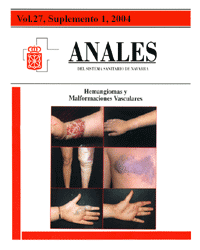Vascular tumors as syndromic indicators
Keywords:
Hemangioma del lactante. Tumor vascular. Hemangiomatosis. Marcador clínico. Síndrome PHACE(S).Abstract
Haemangiomas can be indicators or clue signs for serious syndromes. Although less well known than those related to vascular malformations, there are some syndromes of important diagnostic value that are associated with haemangomias. Early recognition of problematic haemangiomas, together with a prompt intervention, may help to minimise their future morbidity. Neonatal haemangiomas warrant a special follow-up, since their growth pattern might be unpredictable at such an early age. Several clinical presentations are relevant because of their risk of syndromic association: cervicofacial haemangiomas, especially the extensive ones, may be markers for severe dysmorphic conditions like the PHACE(S) syndrome. Those distributed in the beard area are occasionally associated with haemangiomas of the airway. Lumbosacral haemangiomas usually hide an underlying spinal dysraphism or anorectal and urogenital anomalies. Multiple cutaneous haemangiomas may be a sign of visceral haemangiomatosis, most often hepatic, which becomes complicated by cardiac insufficiency or thyroid disease. Finally, there are two vascular neoplasms of rapid and invasive growth – kaposiform haemangioendothelioma and angioblastoma or tufted angioma – which, unlike infantile haemangioma, are markers for the Kasabach-Merritt syndrome.Downloads
Downloads
Published
How to Cite
Issue
Section
License
La revista Anales del Sistema Sanitario de Navarra es publicada por el Departamento de Salud del Gobierno de Navarra (España), quien conserva los derechos patrimoniales (copyright ) sobre el artículo publicado y favorece y permite la difusión del mismo bajo licencia Creative Commons Reconocimiento-CompartirIgual 4.0 Internacional (CC BY-SA 4.0). Esta licencia permite copiar, usar, difundir, transmitir y exponer públicamente el artículo, siempre que siempre que se cite la autoría y la publicación inicial en Anales del Sistema Sanitario de Navarra, y se distinga la existencia de esta licencia de uso.








